Dear Aspirants, Our IBPS Guide team is providing new series of Reasoning Questions for RRB Po Mains 2021 so the aspirants can practice it on a daily basis. These questions are framed by our skilled experts after understanding your needs thoroughly. Aspirants can practice these new series questions daily to familiarize with the exact exam pattern and make your preparation effective.
Input output
Direction (1-5): Study the following information carefully and answer the questions given below:
A word-number arrangement machine when give an input of words and numbers, rearranges the following a particular rule in each step. The following is an illustration of input and steps of rearrangement
Input: 51 ENKO 57 CJRS 14 JQWP 32 MNTV 24 WOLK
Step I: 285 AHPQ 51 ENKO 14 JQWP 32 MNTV 24 WOLK
Step II: 285 AHPQ 204 GPMQ 14 JQWP 32 MNTV 24 WOLK
Step III: 285 AHPQ 204 GPMQ 96 HOUN 14 MNTV 24 WOLK
Step IV: 285 AHPQ 204 GPMQ 96 HOUN 48 OPVX 14 WOLK
Step V: 285 AHPQ 204 GPMQ 96 HOUN 48 OPVX 14 UMJI
Step V is the last step of the above arrangement as the intended arrangement is obtained. As per the rules followed in the given steps, find out the appropriate steps for the given input.
Input: 43 HVJT 21 SMDK 54 LOTI 73 NCTR 47 GUSN
1) What is the difference between the element which is first from the left end in step III and fourth from the right end in step IV?
A.130
B.230
C.481
D.279
E.365
2) How many elements are there between ESQL and QKBI in step V?
A.8
B.5
C.7
D. None
E.3
3) In step II which of the following word or number is 4th from the right end?
A.JXLV
B.43
C.LOTI
D.SMDK
E.21
4) In step V ‘365’ is related to ‘216’ and ‘141’ is related to ‘86’ in the same way which of the following related to ‘PEVT’ in the final output?
A.JXLV
B.JMRG
C.PEVT
D.21
E. None of these
5) In the second last step ‘365’ and ‘JXLV’ interchanges their position then ‘216’ and ‘JMRG’ interchanges their position now which of the following word or number is fifth to the left of ‘21’?
A.141
B.JMRG
C.365
D.216
E. None of these
Blood relation
Directions (6-7): Study the information given below and answer the questions carefully.
There are thirteen members of three generations namely – B, C, D, F, G, H, L, M, N, P, Q, R, and T lives in a family. All are interrelated to each other. Both R and M are male married members of the family. Both T and D are related to G in such a way that the paternal grandmother of D and is the maternal grandmother of T, who is the son of Q. G has only three children. N is the brother-in-law of C and is the only son of L. B is the only daughter of R, who is married to G. F, who is an unmarried member of the family, is the brother of L. P is the daughter-in-law of M and only four married couples are there in the family. L is neither son of G nor he is married to P and is the sister-in-law of H, who is an unmarried member of the family.
6) How is D related to B?
A.Daughter-in-law
B.Nephew
C.Niece
D.Grand daughter
E.Can’t be determined.
7) If ‘P’ is related to ‘L’ in the same way ‘Q’ is related to ‘G’, then who among the following is related to ‘R’ in the same way?
A.G
B.F
C.L
D.C
E. M
Data sufficiency
Directions (8-10): Each of the questions below consists of a question and two statements numbered I and II given below it. You have to decide whether the data provided in the statements are sufficient to answer the question:
a) If the data in Statement I alone is sufficient to answer the question, while the data in Statement II alone is not sufficient to answer the question.
b) If the data in Statement II alone is sufficient to answer the question, while the data in Statement I alone is not sufficient to answer the question.
c) If the data either in Statement I alone or in Statement II alone is sufficient to answer the question.
d)If the data in both the Statements I and II together are not sufficient to answer the question.
e) If the data in both the Statements I and II together are necessary to answer the question.
8) Eight boxes namely -P, Q, R, S, T, U, V and W are kept one above another but not necessarily in the same order. Box R is kept third from bottom at a gap of two from box S, which is kept adjacent to box Q and box P is kept at a gap of one from Q. Which box is kept immediately above box T?
I) Box V is kept at a gap of two from box P. Box W is neither kept at the bottom nor adjacent to box R. Box V is kept at a gap of two from box U.
II) Box U is kept at a gap of two from box V, which is kept adjacent to box R. Box W is kept adjacent to box P.
9) Six persons namely – Raj, Gaurav, Payal, Dev, Riya and Hari are sitting in a circular table facing centre but not necessarily in the same order. Each person likes different pets Parrot, Horse, Monkey, Cat, Rat and Dog not necessarily in the same order. Who sits immediate right of the one who likes Rat?
I) Riya sits second to the left of Dev, who sits third to the right of Gaurav. One who likes the dog is an immediate neighbour of Gaurav and sits second to the right of the one who likes Parrot. One who likes Dog sits immediate right of Raj who likes Cat. Hari sits second to the left of the one who likes Monkey, who is a neighbour of Payal.
II) Dev likes Parrot and sits second to the left of Hari, who sits second to the left of Riya. Payal sits second to the left of Raj, who sits immediate left of the one who likes Dog and Raj likes Cat. The One who likes Horse is an immediate neighbor of Hari. Riya likes monkey.
10) Seven persons namely – Riya, Hema, Golu, Zoya, Hari, Ravi and Jiya are sitting in a row but not necessarily in the same order in such a way that some are facing north while others are facing south. Riya sits third to the left of Hari, who sits at the end of the row and Ravi sits immediate left of Riya. Ravi sits second to the left of Zoya, who is facing south. How many persons are facing south?
I) The immediate neighbor of Zoya sits fourth to the right of Jiya. The person sitting at end of the row facing in opposite direction and Golu sits third from one of the ends. Hari faces north direction.
II) The person sitting immediate left of Ravi sits fourth to the right of Jiya and Golu sits second to the left of Hari.
Answers :
Directions (1-5) :

From the input, the alphabetical order of the first letter in a group of the letter is considered being the first input.

From the input, the second alphabetical order of the first letter in a group of the letter is considered being a second input and so on.
From the input, the largest number is multiplied by 5 and the second largest is multiplied by 4 and so on.
Input: 43 HVJT 21 SMDK 54 LOTI 73 NCTR 47 GUSN
Step 1: 365 ESQL 43 HVJT 21 SMDK 54 LOTI NCTR 47
Step 2: 365 ESQL 216 JXLV 43 21 SMDK LOTI NCTR 47
Step 3: 365 ESQL 216 JXLV 141 JMRG 43 21 SMDK NCTR
Step 4: 365 ESQL 216 JXLV 141 JMRG 86 PEVT 21 SMDK
Step 5: 365 ESQL 216 JXLV 141 JMRG 86 PEVT 21 QKBI
1) Answer: D
2) Answer: C
3) Answer: D
4) Answer: E
5) Answer: C
Directions (6-7) :
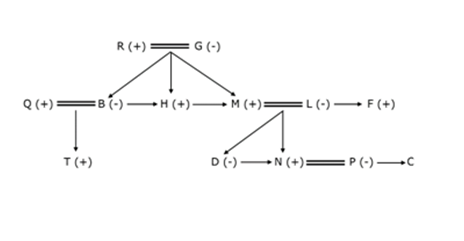
6) Answer: C
7) Answer: C
8) Answer: C
We have:
- Box R is kept third from bottom at a gap of two from box S, which is kept adjacent to box Q that means box S is kept third from the top and we have two different case for box Q, in case (1) box Q is kept immediate above box S and in case (2) box Q is kept immediate below box S.
- Box P is kept at a gap of one from box Q, which means in case (1) box P is kept immediately below box S and in case (2) box P is kept immediately above box S.
Based on the above given information we get:
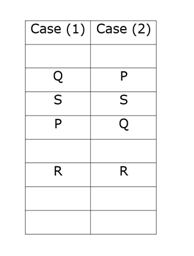
From I:
We have:
- Box W is neither kept at the bottom nor adjacent to box R, which means box W is kept at the topmost position. Box V is kept at a gap of two from box P, which means in case (1) box V is kept immediate below box R and in case (2) box V is kept immediate above box R.
- Box V is kept at a gap of two from box U, which means case (1) is not valid and in case (2) box U is kept at the bottom.
Based on the above given information we get the final arrangement as follow:
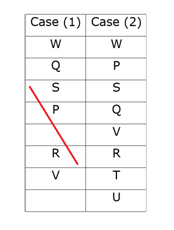
Thus, box R is kept immediately above box T.
Hence, the statement I alone is sufficient.
From II:
We have:
- Box W is kept adjacent to box P, which means in case (1) box W is kept immediately below box P and in case (2) the box W is kept immediately above box P.
- Box U is kept at a gap of two from box V, which is kept adjacent to box R, that means case (1) is not valid and in case (2) box V is kept immediately above box R.
Based on the above given information we get the final arrangement as follow:
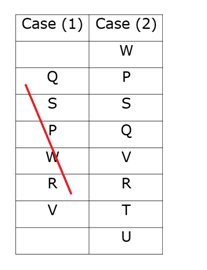
Thus, box R is kept immediate above box T.
Hence, statement II alone is sufficient.
9) Answer: B
From I:
We have:
- Riya sits second to left of Dev, who sits third to right of Gaurav and One who likes Dog is an immediate neighbor of Gaurav.
- One who likes Dog sits immediate right of Raj who likes Cat, that means one who likes Dog sits immediate left of Gaurav. One who likes Dog sits second to the right of the one who likes Parrot, that means Dev likes Parrot.
- Hari sits second to the left of the one who likes Monkey, who is an immediate neighbor of Payal, that means Hari likes Dog.
Based on the above given information we get:
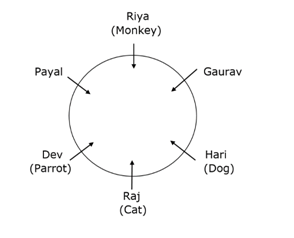
Since, we don’t know who likes Rat, thus result can’t be determined.
Hence, the statement I is not sufficient.
From II:
We have:
- Dev likes Parrot sits second to the left of Hari, who sits second to left of Riya. Payal sits second to the left of Raj, who sits immediate left of the one who likes Dog and Raj likes Cat.
- Riya likes monkey. One who likes Monkey sits second to the right of the one who likes Dog. One who likes Horse is an immediate neighbor of Hari, that means Gaurav likes Horse.
Based on the above given information we get:
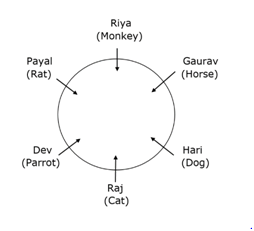
Thus, Dev sits immediate right of the one who likes Rat.
Hence, statement II is alone sufficient.
10) Answer: D
We have:
- Riya sits third to the left of Hari, who sits at end of the row.
- Ravi sits immediate left of Riya and Ravi sits second to the left of Zoya, who is facing south.
Based on the above given information we get:

From I:
We have:
- Hari faces north direction so case 2 is invalid. The immediate neighbor of Zoya sits fourth to the right of Jiya, which means Jiya must facing the south.
- The person sitting at end of the row facing in opposite direction, Golu sits third from one of the ends. Here case 1 also becomes invalid.
Based on the above given information, we have the following result:
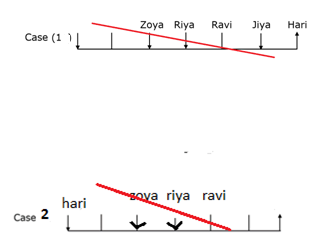
Hence, statement I is not sufficient.
From II:
We have:
- Golu sits second to the left of Hari, which means case 1 and case 2 both are not valid.
Based on the above given information, we get the following result:
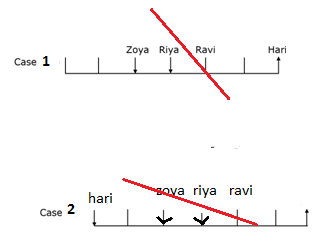
Hence, statement II is not sufficient.
Hence, mstatements I and II together are not sufficient.





